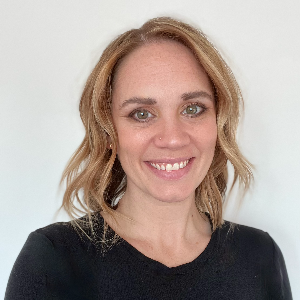Advocating for Your Baby

Why listening to your gut is critical, plus when and how to push back if you feel dismissed by your child’s pediatrician.
By Ashley Ziegler
Medical Experts: Whitney Casares, MD, MPH, FAAP; Tamar Nazerian Chorbadjian, DO, MPH, FAAP
Like all new mothers, I’ve been told how important it is to monitor developmental milestones in my young children. I’ve also been advised that these markers are generalities, so if a child doesn’t meet a milestone exactly on time then it might not be a cause for concern. The conflicting information is meant to provide parents with reassurance, but when you have a baby like my youngest daughter, who consistently meets her milestones a little later than recommended, it’s extremely frustrating.
Indy was born at 35 weeks, so my husband and I knew that throughout the first two years of her life we should be tracking her development based on her adjusted preemie age, meaning she’d most likely hit her milestones later than a baby who is born full-term. Still, even with this accommodation, she was always on the backend or just a little late for every developmental marker. There have never been any glaringly obvious signs that something is wrong, but even early on I knew something wasn’t right. At nearly every baby well-check, I’d bring up her developmental delays to the pediatrician, but they’d give me the standard “every baby is different” line and tell me we’d take the “wait and see” approach.
It was exhausting and infuriating. While I love and respect her pediatrician, it felt like I was screaming into a void. I could feel in my bones that something was wrong, but even though the doctor seemed to listen to me when I expressed concerns, I never felt like I was being heard. It made me think they saw me as an alarmist when all I wanted was to ensure my little girl got the support she needed as early as possible.
At Indy’s 3-year-old well-check, once again, I expressed my concerns over her developmental delay, but to my surprise, her pediatrician agreed that it was time to refer her to a specialist. It was a bittersweet victory. While I was elated that I was finally being taken seriously, I was equally angered because the developmental pediatrician had a 10-month waitlist. I couldn’t help but feel resentful, thinking, if they had just listened to me two years ago, Indy would already be getting the help she needs.
Is Maternal Instinct Real?
What we went through with Indy is something a lot of parents face. We knew something was off with our child, but since we aren’t the experts there was only so much we could do about it. Some call this intuitive feeling “mommy gut”, a “mother’s intuition”, or simply maternal instinct. And if you’ve ever felt it, you’d swear the phenomenon is real—but what does science say?
There have been studies to examine whether or not “maternal instinct” is real, and it turns out that it’s not unique to biological mothers—or even women—at all. One study found that dads are just as capable as moms of identifying and deciphering their baby’s cries (which is how “maternal instinct” is measured). Another found that this ability is a skill that anyone can learn with enough exposure to a single baby.
Additionally, oxytocin (or the “love hormone”) levels are another considerable factor in “maternal instinct.” One study involving mice found that with enough exposure to the chemical, any mouse can develop this same intuition, whether they are a biological parent or not. A woman will experience a natural release of oxytocin during labor, delivery, immediately following birth, and every time they breastfeed, giving biological mothers (particularly breastfeeding birth moms) a leg up in exposure and bonding compared to their partners, which could explain why this “instinct” was originally attributed solely to mothers. So, basically, a lot of research indicates that this “gut feeling” is actually a reflection of a parent’s unique bond with their baby.
Still, just because this feeling is not an animalistic instinct, doesn’t mean the nagging voice of concern in your head isn’t worth your attention. “I always tell parents, ‘remember, you know your child best,’” says Tamar Nazerian Chorbadjian, DO, MPH, FAAP, a developmental-behavioral pediatrician and director of high-risk infant follow-up care at Kaiser Permanente in Los Angeles, “so don’t ever stop being that advocate for your child.” There is no one more qualified in your child’s developmental behaviors or well-being than you, so it’s essential that you communicate any concerns you have with their doctor.
The “Wait and See” Response
We can all assume that our children’s pediatricians are knowledgeable and are practicing in good faith, which means they are fully aware that parents know their individual children best (whether they agree with the idea of maternal instinct or not). So then why does it sometimes feel like they’re brushing off our concerns—especially when it comes to our baby’s development?
“Pediatricians know from seeing countless babies and young children that many developmental and behavioral issues resolve themselves over time and that every child is unique,” says Whitney Casares, MD, MPH, FAAP, a pediatrician in Portland, Oregon and founder and CEO of Modern Mamas Club. She adds, “Pediatricians use standardized tools to assess if a child is meeting criteria for a developmental delay, and [they] are highly attuned to detecting behavioral disorders.”
Dr. Chorbadjian mentions these standardized tools, too, and points out that up until an update in February of this year, the Centers for Disease Control and Prevention (CDC) and the American Academy of Pediatrics (AAP) milestone guides were somewhat vague, which encouraged a “wait and see” approach.
“Part of the reason the CDC updated their milestones tracker is because the old model listed milestones where 50% of children should be,” she explains, “So, if your child did or didn’t meet a milestone, it was OK to say, let’s just ‘wait and see, maybe they’ll do it by their next check-in.’”
Since the CDC released its new guidelines, parents may have noticed their child’s pediatrician is more willing to act on developmental delays than before. This is because the new markers represent where 75% of kids should be, leaving less gray area and making it easier to identify outliers.
Unfortunately, another reason your child’s pediatrician may appear to be brushing you off is simply due to time constraints. Dr. Chorbadjian points out that pediatricians are tasked with evaluating a lot of things in a short well-baby or well-child visit, which often does not allow them to focus on a single concern for very long.
“The pediatrician sees a child in this snapshot of time during their visit. They get 10, a maximum of 15 minutes, if they’re lucky, to see the patient. During that time they have to cover family history, child development, do a physical exam, check on food insecurity, mental health, psychosocial issues, vaccination, sleep, and eating.”
Because of this time constraint, she says if parents aren’t adequately communicating their degree of worry, a provider may quickly address the concern with “let’s just wait and see” and continue to tick off boxes on their to-do list. As a parent, you might walk away from the appointment feeling dismissed while the provider has no idea they gave you that impression. A good pediatrician doesn’t want caregivers to feel this way, which is why clear communication is key for both of you.
Parents who express concern specifically about autism spectrum disorder (ASD) may also likely be met with a recommendation to “wait and see,” according to Dr. Chorbadjian, and this is simply because it’s a hard condition to diagnose at a young age.
“The 18-, 24-, or 30-month developmental milestones are when we look for signs and symptoms of autism at the earliest,” she says, “anything earlier than 18 months should really be diagnosed by a specialist. Usually, 12 months is the earliest that you can start seeing true signs of autism. Before then, there might be some red flags but there’s still a lot of room for growth.”
Whether a parent is worried about ASD or their child’s development or behavior in general, there are a variety of valid reasons why a provider may apply this method of approach to a child’s care. However, Dr. Casares emphasizes that this recommendation isn’t an indicator that the provider isn’t taking the parent’s concerns seriously because pediatricians know that the earlier you address developmental delays, the better.
“In order to make sure children with a true developmental delay or a severe behavioral issue get the help they need from overloaded specialists, [pediatricians] will often take a ‘wait and see’ approach on the children who may just need a little more time. That said, pediatricians don’t wait for long. If based on their clinical judgment they’re concerned [about a child], they will be quick to take action.”
Tips for Respectfully Communicating Your Concerns
It’s easy to understand why a parent might be hesitant to push back on this recommendation with a pediatrician they trust for the sake of the patient-provider relationship, but I can tell you from experience that if you don’t speak up and ask clarifying questions, you will kick yourself for it later. As a mom who has been through this scenario with a child, I know how a pediatrician’s suggestion to “wait and see” can leave you feeling defeated and helpless long after the appointment is over.
Uncomfortable as it may be to challenge your child’s doctor, it’s important to remember that you’re the parent and it is your right and responsibility to make sure your kid is getting the care and attention they need. It’s OK to press a provider on something like this, just as long as you’re doing it in a way that is respectful.
Dr. Casares says, “Healthy communication with your child’s pediatrician is critical,” but adds, “Above all, though, assume good intent and keep a team mindset. If you’re worried, advocate for your child by expressing it in a kind, assertive way to your child’s pediatrician that you have an elevated level of concern. Your pediatrician wants to help you and your child and wants to work alongside you to ensure your little one thrives.”
Dr. Casares also suggests parents:
- Opt for human-to-human interaction whenever possible. Don’t show up to an office visit with an exhaustive list of questions or send the doctor an accusatory email.
- Be direct. Ask your child’s provider their level of worry; if it doesn’t match your own, tell them. Ask them to explain how they’re thinking about the situation based on their knowledge and experience so you can better understand their thought process.
Dr. Chorbadjian’s tips for caregivers include:
- Bring videos and/or pictures of your child to help the provider see what you’re seeing at home—your child may not demonstrate the concerning behavior during an office visit, which doesn’t give a pediatrician much to work with.
- Use the CDC checklists and Milestone Tracker app and refer to the list when you bring up a developmental concern to your child’s provider.
- Make a dedicated appointment to discuss a specific concern, that way it will be the sole focus of the visit (unlike a check-up), and you’ll have ample time for conversation.
- Don’t wait until the next well-child check to follow up. If you have a concern about your child’s development that you brought up at their 18-month visit and you felt like you were a little dismissed, don’t wait until the 24-month visit. Schedule something in about two to three months to follow up.
- Use caution when researching on your own. “I always want parents to be very mindful of where they’re getting their resources from. If you are getting something on TikTok, I want you to compare it to something you read on the CDC website, the AAP website, or your pediatrician’s handouts.”
ASD-specific tips
Dr. Chorbadjian advises parents who are specifically concerned about ASD to keep an open mind. She explains that since more is known about ASD now than in the past and it’s become a more common diagnosis, there are a lot of misconceptions about it.
“I often see people get misdiagnosed with ASD when it’s actually something else that’s a lot more manageable,” she says. “A lot of times if a child is covering their ears, or flapping their hands, or has other sensory issues, like toe-walking or [something] speech-related, parents automatically assume it’s ASD, but some of these behaviors can actually be developmentally appropriate” in children without ASD.
Similarly, she says many of the symptoms that are commonly associated with ASD are also symptoms of other diagnoses. “These symptoms, like the sensory issues, or the speech delay, the repetitive behaviors, or the obsessive, restricted interest can also occur in a lot of other conditions like global developmental delay, intellectual disability, anxiety, even ADHD.” Because of this, she urges parents to be open to the idea of different diagnoses when discussing these symptoms with their child’s pediatrician (or even a specialist). “Definitely be the best advocate for your child,” she says, “but at the same time, be mindful and open-minded that there may be something else going on.”
Developmental Support Without a Pediatrician Referral
There are plenty of valid reasons why your child’s pediatrician might not immediately take action when you express concerns about your child’s development or behavior, but that doesn’t mean you can’t take steps on your own to get your child support. There are a handful of ways to have your child evaluated by professionals without a referral from a pediatrician.
First, check your insurance plan to find out if you have to have a referral to see a specialist. A lot of plans don’t have this requirement, so you may be able to get your child an appointment simply by calling the practice. One thing to note, though, is that developmental pediatricians and neurologists are few and far between, meaning they see a lot of patients and have long waiting lists. Because of this, many practices require a pediatrician’s referral, regardless of your insurance plan, just to ensure they’re prioritizing patients appropriately.
If you can’t get in with a specialist, or if you’re stuck on a long waitlist, the good news is that a developmental pediatrician isn’t your only hope to get your child help. There are other options:
- Every state has an early intervention program that’s funded by the federal government and free for families. It’s for children up to 3 years old and offers evaluations as well as support and therapies for those who qualify. Learn more here.
- For kids 3 years old and up, many public school systems offer services (often for free) like speech and occupational therapy for those who qualify. Additionally, school systems may retain records from these therapies to help make the transition into kindergarten easier. What’s more, these records can be used to help create individual education plans (IEPs) for students who need extra support in the classroom. Contact your public school system to find out more.
- Many private speech and occupational therapist offices will evaluate children without a pediatrician’s referral and provide services to kids who meet their qualifications (some insurance plans even cover these interventions).
All three of these options are available to most families, but every state and provider does things a bit differently, so you’ll probably need to do a little research to find out how to access these services for your child. But, as a mom who has utilized all of these services for her daughter, I will say it’s worth the effort—especially when your child is on a 10-month waitlist to see a specialist.
Again, remember that you are the expert on your child, so if you just know that something is off with their development, clearly communicate your level of concern to their pediatrician so that you can work as a team to help your child. Your child’s health care provider should never outright dismiss your concerns, and if you feel that they are, then it might be time to find a new practice. “Sometimes a pediatrician is not a great fit for you and your family, and that’s OK,” says Dr. Casares, adding, “Don’t be afraid to develop a medical team around you and your family that feels supportive and collaborative.”








